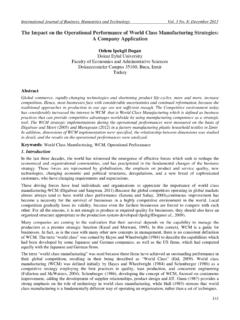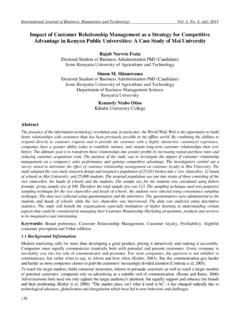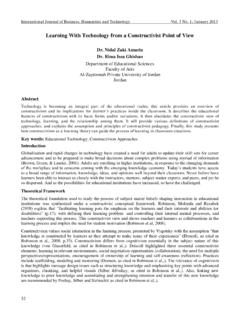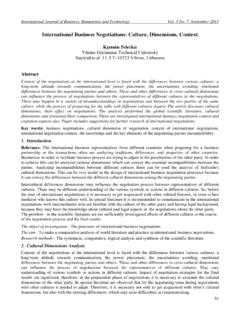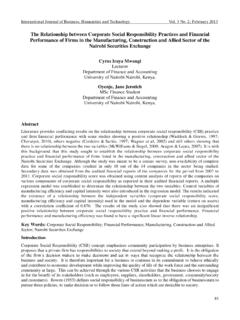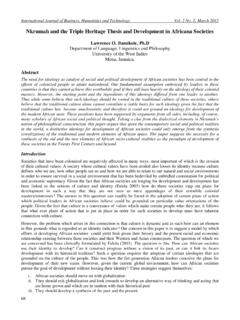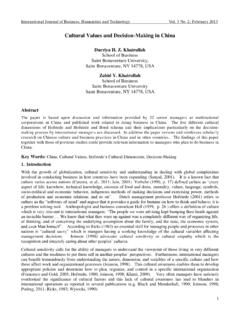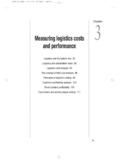Transcription of The Impact of Inventory Management Practices on Financial ...
1 International Journal of Business, Humanities and Technology ; May 2013 75 The Impact of Inventory Management Practices on Financial Performance of Sugar Manufacturing Firms in Kenya Timothy Lwiki Lecturer in Accounting & Finance Sigalagala National Polytechnic Box 2966-50100, Kakamega Kenya Patrick Boniface Ojera, Phd School of Business & Economics Maseno University Box Private BagMaseno Kenya Nebat Galo Mugenda Lecturer in Accounting & Finance Chuka University Box 109-60400 Chuka-Kenya Virginia Kirigo Wachira Department of Accounting and Finance Meru University of Science & Technology Box 972-60200 Meru-Kenya Abstract Manufacturing firms apply various techniques in the Management of their inventories.
2 The Practices adopted have a significant Impact on returns, profitability and volume of sales. Manufacturing firms that efficiently apply these Practices have an excellent Financial performance. This paper examines the Impact of Inventory Management Practices on the Financial performance of sugar manufacturing firms in Kenya, by analyzing the extent to which lean Inventory system, strategic supplier partnership and technology are being applied in these firms. The research survey was conducted in all the eight operating sugar manufacturing firms from the period 2002- 2007. The primary data was collected using structured and semi- structured questionnaires administered to key informants in the organizations.
3 Secondary data was obtained from annual Financial performance statements available in the year Book sugar statistics. Descriptive statistics was used to test the Impact of Inventory Management Practices and Correlation analysis was used to determine the nature and magnitude of the relationship among Inventory Management variables. The results indicate that there exists a positive correlation between Inventory Management and Return on Sales (r= ) and also with Return on Equity (r= ) which were found to be statistically significant at 5% level. Key Words: Inventory Management , Financial Performance, Return on Sales, Return on Equity, Sugar Manufacturing Introduction managing assets of all kinds can be viewed as an Inventory problem, for the same principles apply to cash and fixed assets (Koumanakos, 2008).
4 The tradeoff between ordering costs and holding costs characterizes the transactions approach to Inventory Management represented by the EOQ models of Inventory developed many decades ago (Koumanakos,2008). In the recent years, as the field of operations Management has developed, many new concepts have been added to the list of relevant Inventory control topics. Center for Promoting Ideas, USA 76 These more Management oriented concepts include the materials requirements planning systems (MRP) Just-In- Time (JIT) and ERP methods while another emerging stream of studies postulate that the characteristics of a firm s demand and marketing environments also play an important role.
5 In determination of optimal corporate inventories, notwithstanding the theoretical and practical short comings inherent in these concepts and techniques, their application in real business life should have an effect on firm s performance (Koh, Demirbag, Tatoglu and Zaim, 2007). Building on this situation, the purpose of this study is to investigate the relationship, if any, between Inventory Management Practices and Financial performance of sugar manufacturing firms in Kenya. Inventory Management is viewed as a significant blend of the key performance determinant variables in sugar industry. Inventory Management and control are crucial to a firm because mismanagement of Inventory threatens a firm s viability (Sprague and Wacker, 1996).
6 Too much Inventory consumes physical space, creates Financial burden, and increases possibility of damage, spoilage and loss. In this context the lean production principle pioneered by Womack et al (1990) has been linked to reduced inventories on the other hand, too little Inventory often disrupts manufacturing operations and increase the likelihood of poor customer service. The Concept of Inventory Management Inventory refers to the value or quantity of raw materials, supplies, work in progress (WIP) and finished stock that are kept or stored for use as need arises (Lyons and Gillingham, 1981). Raw materials are commodities such as steel and lumber that go into the final product.
7 Supplies include items such as Maintenance, Repair and Operating (MRO) Inventory that do not go into the final product. Work in progress is materials that have been partly fabricated but are not yet completed. Finished goods are completed items ready for shipment (Kothari, 1992). Inventory Management is the art and science of maintaining stock levels of a given group of items incurring the least cost consistent with other relevant targets and objectives set by Management (Jessop, 1999). It is important that managers organizations that deals with Inventory , to have in mind, the objective of satisfying customer needs and keeping Inventory costs at a minimum level.
8 Drury (2004) asserts that Inventory costs include holding costs, ordering costs and shortage costs. Holding costs relate to costs of having physical items in stock. These include insurance, obsolescence and opportunity costs associated with having funds which could be elsewhere but are tied up in Inventory . Ordering costs are costs of placing an order and receiving Inventory . These include determining how much is needed, preparing invoices, transport costs and the cost of inspecting goods. Shortage costs result when demand exceeds the supply of Inventory on hand. The costs include opportunity costs of making a sale, loss of customer goodwill, late charges and similar costs.
9 Theory of Economic Order Quantity (Wilson EOQ Model) Mathematical models have been developed within the scope of operations Management to determine the optimal Inventory level. The most widely used model is the EOQ model. This model was developed by in 1913. But still Wilson is given credit for his early in- depth analysis of the model (Arsham, 2006). The model is also known as the Wilson EOQ model. According to this model, some costs (ordering costs) decline with Inventory holdings, while others (holding costs) rise and that the total Inventory -associated cost curve has a minimum point. This is the point where total Inventory costs are minimized.
10 The economic order quantity is the level of Inventory that minimizes the total of the Inventory holding cost and ordering cost. The graphical representation of EOQ model is shown in figure 1 below: International Journal of Business, Humanities and Technology ; May 2013 77 Figure 1: EOQ Model Cost (sh) Total Cost Holding cost Ordering cost EOQ order size Objectives of Inventory Management Magad and Amos (1989) assert that the primary objective of Inventory Management is to improve customer service. This is done through protection against stock out due to demand variability in the market place.
